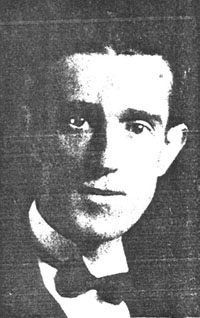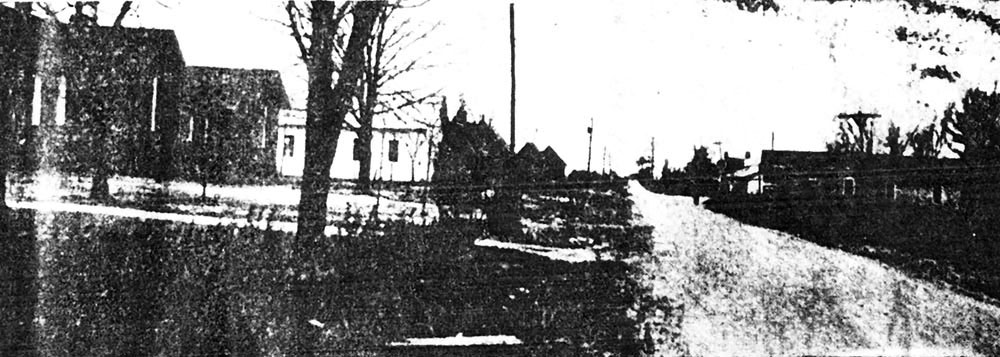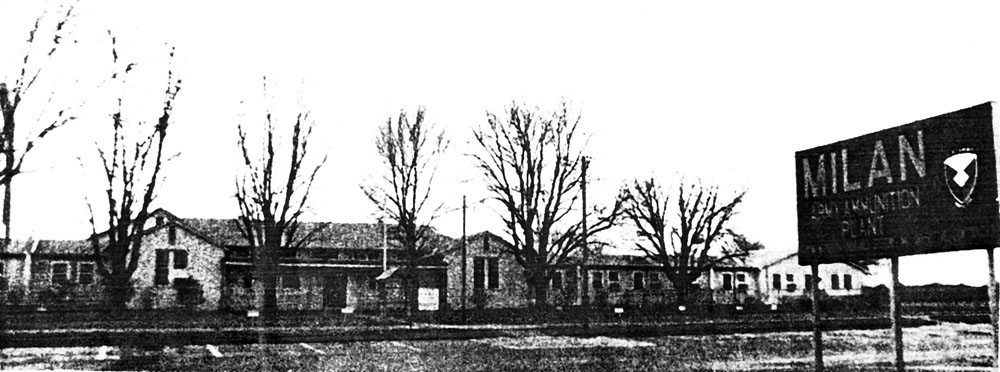yesterday's tennessee


HERVEY DICKEY, photographed a
few years before the arsenal came to
Milan.
According to Dickey's
recollection, his telephone conversation
with a
Washington official
was the
first step in a series of highly secretive
negotiations
that brought the huge
shell-loading plant and ammunition
storage area to Milan.
In this “Homecoming Sketch,” G. Hervey Dickey tells the fascinating, behind-the-scenes story of the government’s decision to build a huge ammunition manufacturing plant and storage facility near a small, truck-farming town in Gibson County.
“The arsenal was a result of England and France having been at war with Germany,” recalls Mr. Dickey.
“England needed ammunition, and they knew a plant in England would be bombed, so they asked the U. S. to make ammunition and load it on English ships.”
“It was decided that a plant should be located on two major railroads and far enough from the coast so that it could not easily be reached during an invasion. Also, it had to be far enough from the Mississippi River that enemy submarines or boats could not reach the plant.”
“At that time (1940), the major railroads had offices in Washington, D. C. The Illinois Central representative heard of the plans to build a plant and he wanted to locate the plant on the I. C. railroad. His brother was in charge of the I. C. railroad’s industrial office in Chicago. The two brothers arranged to have U. S. Army representatives look at location sites on the I. C. railroad.”
“The Washington I. C. representative was friends with Mr. Bond Wilkinson, the I. C. agent at Jackson, Tennessee. It was arranged for Colonel Holmes and two other Army officers to go to Jackson to look for a site for the proposed plant.”
“The Army officials came with a view of finding one tract of land that would be large enough for the entire plant. The land at Jackson, however, was not suitable, because the land south of the city would overflow, and the land to the north was not (geographically) satisfactory.”
“So the men were ready to move on to Corinth, Mississippi.”
“Mr. Wilkinson and I were working very closely on the I. C. industries. He asked the Washington men to allow him to contact me. I told them there was no one tract of land east of the Mississippi River sufficient for the plant, but I felt certain I could get several pieces of land together and have the acreage they needed.”
“The men from Washington replied, “Can you do this?”
“I told them I could, and the result was they came up to Milan and eventually, the farms and other land in the arsenal area were purchased for the present arsenal site.” (The arsenal covered 28,372 acres.)
“When it was decided that the plant should be located in Milan, there was a tremendous amount of politics involved. The utmost secrecy had to be observed.”
“We had to contact men high up in Washington, D. C. It was so secretive that even the Secretary of State and Senator from Tennessee had no knowledge of it. Cordell Hull, Secretary of State knew nothing about the plant. He was in the Washington train station about to leave on a vacation. John Denney contacted Mrs. Hull and she had her husband paged in the station. He cancelled his vacation to devote his attention to the plant coming to Milan.”
“Senator McKellar, who was living in Memphis knew nothing of the arsenal. Mr. Ben Ivy King went so see him. They met at the Gayoso Hotel and Ben Ivy King told Senator McKellar about his arsenal. The Senator left immediately on the next train for Washington. He and Cordell Hull went to work to make sure the plant would be located in Milan.”
“On December 12, 1940, Senator McKellar wired Ben Ivy King from Washington and told him that the plant would be come to Milan. Ben Ivy King immediately showed me the telegram. He went to the Milan Bank and showed it to Moore Blankenship and John Denney. So we four were the only ones who knew about it outside of Washington.”
“There was a lot of work involved and the most profound secrecy was maintained. Mr. Moore Blankenship and I went to work at 2 a.m. laying the foundation plans. The men from Washington would not come to Milan in the daytime or arrive on the same train together. They stayed in hotels in Jackson and we worked at night in the Milan Bank.”
“The first man to come to Milan in connection with the construction was a Mr. Henry Birdseye from the department of engineers in Washington. He came to my office one day and asked me to go outside.”
“He said, ‘I’m from the engineering department in Washington,’ and then he half-whispered, ‘Do you know anything about the government going to do some work here in Milan?’”
“I said, ‘Yes.’”
“He said, ‘I have come to make a survey and contour map of that area to send back to Washington so they may lay out the plans. I need some help.’”
“I said, ‘Man, there’s not a surveying instrument in this little town. There’s not a single engineer in this town. Have you ever been to Memphis?’”
“He said, ‘No.’”
“I said, ‘In Memphis, there’s a very famous street – Beale Street. And on this street there ware several blocks of nothing but pawnshops. In the windows of these pawn shops you will find surveying equipment – transit levels, tripods and tables – and you can buy them by paying what they have pawned. I can get you the engineers from the Illinois Central. How many do you want?’”
“He said, “Let me have six.’”
“So he took the next train on the L&N into Memphis and went to Beale Street. He bought six transit levels and tripods, and he sent them to me via express. The express man called me up and wanted to know what I wanted with all that surveying equipment.”
“Then he came, and I had the engineers to meet him, and so they started to work. They went to Whitthorne, rented the old school building that was vacant for an office, and they made a survey of the entire area and sent it to Washington to lay out the plant.”


BEFORE & AFTER-The community of Whitthorne (upper photo) as it appeared just before construction of the arsenal. The school building is shown at left and is the site of the present administration office building. This photo was made by the Jackson Sun photographer Al Drews in December, 1940. Construction started in late January 1941, and the first shell was loaded on "A" line on September 15, 1941.
Lower photo: Milan Army Ammunition Plant administration building as it appears today. The offices were constructed around the old Whitthorne School building. The arsenal continues to play a major role in the Milan economy; payroll in 1984 was $33.2 million and plant property is valued at about $750 million.
"The original cost of the construction was $65 million. That was staggering in those days - unbelievable. A construction firm was formed by H. K. Ferguson & Co. from Cleveland, Ohio and Oman Construction Co. of Nashville to build the plant."
"It was a very fact operation. Peak employment during the construction was 15,000 people, it was unbelievable for a little town like Milan. But it was so necessary that it be done quickly that they threw money aside and went all out to build this plant."
"I was with the railroad, and they had to have railroad men to build and operate the railroad. A man named Stanely Mills and I went out here to build and operate the railroad."
"The Illinois Central gave the arsenal construction company 300 cars of cinders to make driveways and highways. On the railroad one day, I loaded 77 carloads of ballast on the track for the railroads. That shows you how big of a scale this thing was on."
"Proctor and Gamble was chosen the contracting operator of the plant. That was because they had been accustomed to taking powder and putting it into packages of soap. They figured if Proctor and Gamble could do that, they could handle powder and TNT."
"Proctor and Gamble called me from their Cincinnati office and asked me questions about this plant and the land and so forth. The name of the plant was Wolf Creek Ordinance Plant, and one question they asked me was, 'Does this Wolf Creek every overflow?'"
"Proctor and Gamble was to operate the shell-loading plant, but the storage area was separate from the ordinance plant and was operated by the government. They built 700 concrete warehouses called 'igloos' to store ammunition. Later the two plants were combined and the name was changed to Milan Ordinance Plant. It later became known as the Milan Arsenal."
"There were enormous amounts of employees. Enormous amounts of millions of dollars were paid to employees. And the money for expansion and for construction was beyond the conception of any of us. The country town of Milan was thrown into an unbelievable mass of activity."
top · home · yesterday's · families · schools · links · what's new · memorial · about
This site was created by David Donahue and Brenda Kirk Fiddler.
This site is currently maintained by Jerry L. Butler
Copyright © 2004 - 2010, All rights reserved